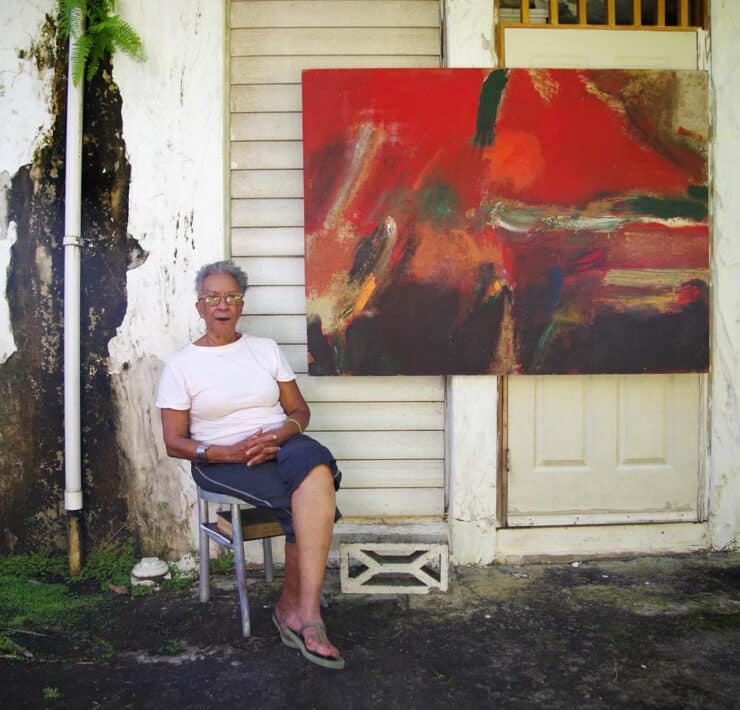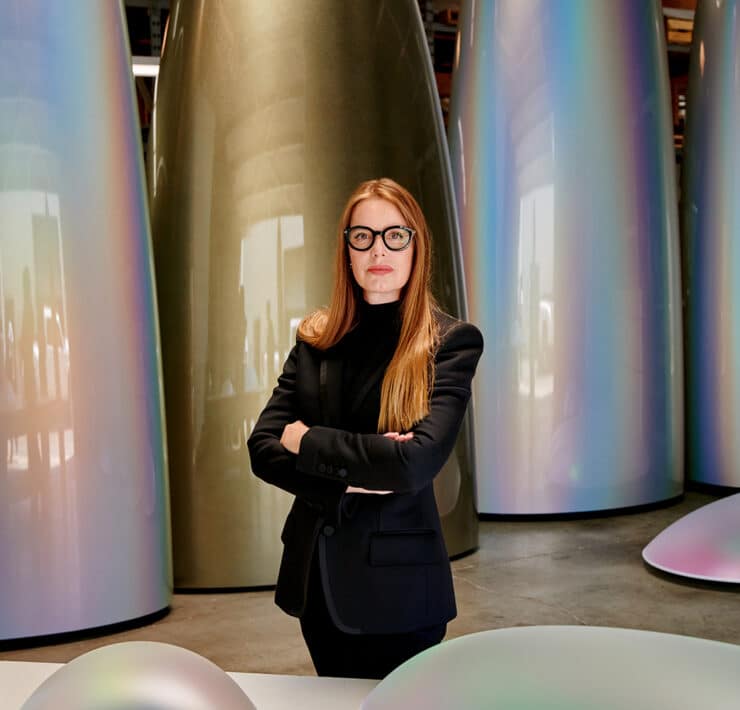
Through her interdisciplinary practice, artist Maria Gaspar addresses issues of spatial justice and questions our relationship to power. Her source of inspiration is none other than one of the largest lockups in the United States—Cook County Jail, which happens to be located in the neighborhood of her upbringing. Gaspar responds to the complexities that this location proposes to its community and invites us to envision a more just world.
I had the pleasure of having a conversation with Maria about her expansive practice and her position on visibility and representation for Latinx communities.
Please tell us about the beginnings of your career and what experiences led you to become the artist you are today.
My artistic practice was formed at an early age. Between performing with my mother, who did a stint as a clown for some time, painting murals, and collaborating with friends on community-based art projects since childhood, art was an everyday part of my life. As a young artist, I sought opportunities that affirmed what an artistic life or a lived practice could be—something deeply embodied. I was also fortunate enough to have a support system made up of local artists who mentored me as well as teachers who helped me imagine my future.
Growing up on Chicago’s West Side had its challenges. In my immediate neighborhood, there were too few options for cultural engagement, so I mostly left my community to attend programs or connect with other artists. I learned firsthand how social inequities permeated the city, and that would go on to play a major role in my arts practice.

Photo courtesy of Maria Gaspar
Your ongoing site-specific series, titled “Disappearance Suits,” is currently at El Museo del Barrio in NYC as part of the Estamos Bien Triennal. Tell us about this body of work and why its inclusion in this contemporary Latino national survey is so important.
“Disappearance Suit” began in 2012, when a few ideas I was researching and experimenting with inside and outside the studio began to merge. I was making work about visibility and being a first-generation Latinx person whilst making public art and doing performance art. During this time, I was deeply invested in materiality and the color brown as a signal for my immigrant identity. A series called “Brownouts” became a space to play with color, opacity, and legibility—perceptually and politically. At the time, my site-specific projects were entirely constructed in urban, dense landscapes. Therefore, I decided to travel to Iceland during the season of the “midnight sun” to study the color brown in an entirely different environment.
My first suit was made of brown latex paint and spray paint. I staged a series of performances in this suit during different times of the day as I traveled across Iceland. Needless to say, Iceland is a very homogenous country, so this certainly played a part in the development of the performance. Since then, I have continued the series in various locations, including Switzerland and the West and East Coasts of the US. Each suit is a response to the politics of location and is usually constructed from local materials.
The suits and stills of the performances are being exhibited together for the first time at El Museo de Barrio. It was exciting to work with the curators to contextualize the work within the larger conversation about Latinx identity and all its fluidity, and among so many friends and folks I admire in the field. Institutionally, I think we need to reassess places like museums as well as art schools, civic organizations, and foundations. Who has been historically left out?

Photo by Scrappers Film Group
You have built an impressive career, with stellar national recognition for your work as well as for your research regarding social justice and the politics of location. Can you tell us about your motivations behind this project, and why it continues to be a topic so close to you? How does this passion for social justice manifest itself in your practice?
I am so grateful for the support I have received. It has been a labor of love because the work is not always recognized, and that’s OK. My mentors taught me how to keep going even when times are tough because of my belief in the work and because the work brings joy, tenderness, and vitality. It’s even more special when others you are working with experience all that beauty and transformation too, and when something inside you feels lifted, affirmed, seen, or full. That is perhaps how I view my commitment to social justice. It’s not about the grand, but about the intimate: how I care for others and how I hope others care for me, for my son, my family, or my community. To me, justice is one of the greatest acts of love, and my community continues to teach me those lessons . . . I am still learning.

Photo by Scrappers Film Group
When the color brown was not a topic of conversation in the mainstream, you were already addressing it visually through installations and performative work. Books like The Sense of Brown by José Esteban Muñoz have now reached mainstream America, making this topic a bit more familiar to general audiences. Can you talk about this journey and what motivated you to elevate the importance of the color brown in your work?
I think we would be better people if we all read José Esteban Muñoz’s writing, and I do envision a time where it is in the mainstream. Wouldn’t that be amazing?! I feel rage and sadness about our current political moment in the US, where states are attacking critical race theory, transgender rights, voter rights, and caging children and families in immigrant detention centers.
Muñoz beautifully articulates “brownness” in the realm of both trauma and potentiality. I think about his work in relation to art making and life making, in relation to poetics and politics. “Brownness” resonates with me in so many ways because of my own interest in making work about being in and with dislocated communities, dealing with extraction, and seeing and feeling absence and erasure. Nevertheless, in my experience working with incarcerated communities and other system-impacted people, vitality and life persist, and the complexity of this reality requires humanity and subtlety.

Photo by Ronald L. Jones
How do you feel about the lack of representation of Latino artists in museum collections and the art market? Why should museums provide Latino representation in their collections?
We might need a whole issue, or many issues dedicated to these important questions. For brevity, Latinx artists are here. We have been making work. We have been making our own spaces because majority-white spaces have excluded Latinx and other marginalized communities. And we have been driving culture and cultural movements. Museums and other institutions should support the critical work being made by Latinx artists if they want to be relevant now and in the future. Institutions need to do the internal labor and acknowledge the systemic impact of white supremacy and colonialism and take concrete steps in creating truly inclusive, critical, caring, and relevant institutions. I want my kid to be able to go to a major museum in the US and see himself in the collection.
You have had an incredible artistic career, secured a professorship at the School of the Art Institute of Chicago, and been a terrific mother on top of that. Is there anything you would still like to explore?
Thank you. I feel like I just got started! There are a million things on my list, and this COVID time has only affirmed my tenacity. Managing an art practice, a full-time teaching load, and other projects while also raising a toddler has not been easy. I hope more institutions also recognize artist parents, especially mothers whose jobs have been gravely affected throughout this pandemic. Besides some major projects, I am exploring how I can support other artist mothers in my teaching and projects and how to advocate for one another in the field.
Puerto Rican born, Edra Soto is an interdisciplinary artist and codirector of the outdoor project space the Franklin.
Recent venues presenting Soto’s work include Crystal Bridges Museum of American Art’s satellite, the Momentary (Arkansas); Albright-Knox Northland (New York); Chicago Cultural Center (Illinois); Smart Museum (Illinois); and the Museum of Contemporary Photography (Illinois).
Recently, Soto completed the public art commission titled Screenhouse, which is currently at Millennium Park. Soto has attended residency programs at the Skowhegan School of Painting and Sculpture, Beta-Local, the Robert Rauschenberg Foundation Residency, the Headlands Center for the Arts, Project Row Houses, and Art Omi, among others. Soto was awarded the Efroymson Contemporary Arts Fellowship, the Illinois Arts Council Agency Fellowship, the inaugural Foundwork Artist Prize, and the Joan Mitchell Foundation Painters & Sculptors Grant, among others. Between 2019-2020, Soto exhibited and traveled to Brazil, Puerto Rico, and Cuba as part of the MacArthur Foundation’s International Connections Fund.
Soto holds an MFA from the School of the Art Institute of Chicago and a bachelor’s degree from Escuela de Artes Plásticas y Diseño de Puerto Rico.
Puerto Rican born, Edra Soto is an interdisciplinary artist and codirector of the outdoor project space the Franklin. Soto has been awarded the Efroymson Contemporary Arts Fellowship, the Illinois Arts Council Agency Fellowship, the inaugural Foundwork Artist Prize, and the Joan Mitchell Foundation Painters & Sculptors Grant, among others.







